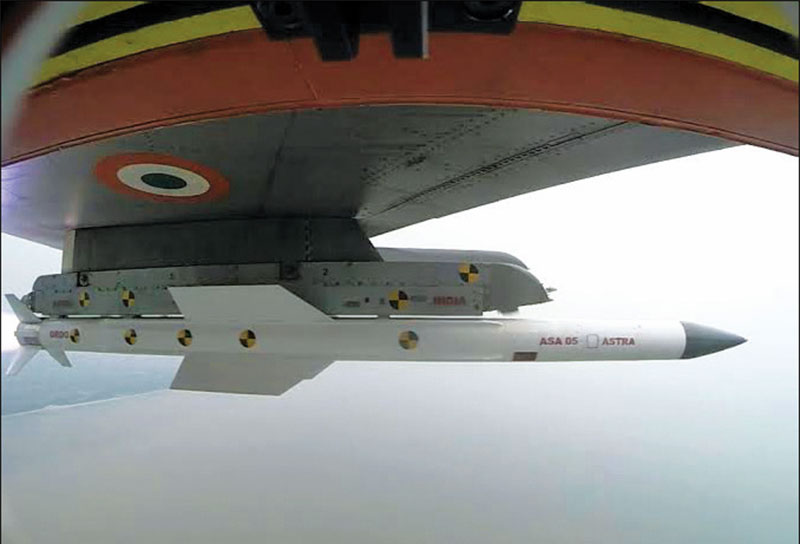India will be well prepared for regional dominance in air-to-air combat with the Astra BVRAAM slated for induction this year
Mihir Paul
India’s first air-to-air missile, the Astra, is spearheading the country’s missile-making capabilities. Developed by the Defence Research and Development Organisation (DRDO), this beyond-visual-range (BVR) air-to-air missile is capable of engaging aerial targets at distances up to 80km.

While Astra’s preliminary work started in 1990, it has since undergone multiple modifications and rounds of successful test-firings. It is already integrated successfully into the IAF’s Su-30MKIs, Mirage 2000s, and will be integrated into the MiG-29s in the future. The missile retains a high Single Shot Kill Probability (SSKP) making it highly reliable. It comes fitted with a high-explosive pre-fragmented warhead and can reach speeds of up to Mach 4.5.
It is also an all-weather missile with active-radar terminal guidance, electronic counter-counter-measure (ECCM) features, smokeless propulsion, and process improved effectiveness in engaging multiple targets. Its advanced onboard ECCM features can jam radar signals from enemy aircraft, making it extremely difficult to track the missile’s course.
The ambitious Astra BVR missile underwent its trial by fire in September 2017 when it completed its first round of final developmental trials. This was the missile’s first live-fire test. According to the ministry of defence (MoD), the trials conducted off the Odisha coast on 11-14 September 2017 saw seven Astra missiles fired from a Sukhoi-30MKI fighter at pilotless aircraft that were designated as targets. All seven Astras hit their targets.
Following this test, later in 2017, the Astra was cleared for limited series production at Bharat Dynamics Limited’s (BDL) manufacturing facility at Sangareddy, Telangana for an initial order of 50 missiles. This was a major developmental milestone for the country as this was also the first time when the missile was test-fired successfully with a fully indigenous seeker developed by DRDO. The earlier Russian Agat 9B1103M active-radar seeker was replaced by DRDO’s Ku-band seeker developed at the Research Centre Imarat (RCI).
The Ku-band seeker has been a significant upgrade over traditional active radar seekers since it allows for locking onto targets emitting high-frequency electromagnetic signatures which allows for more precision and improved tracking. With the successful integration of the indigenised Ku-band seeker, the Astra became 100 per cent indigenous making it one of the major landmark defence projects in India.
The missile was test-fired again in 2018, from September 26 to October 3 at the Integrated Test Range (ITR), Bangalore as part of its final developmental trials. Again, like in 2017, an IAF Su-30MKI fired the missile against an unmanned aerial target. According to the MoD, the missile was able to successfully track and hit its designated targets. The trials were described as a combination of complex tests for engagement of unmanned targets in different modes of manoeuvring, off-boresight, at medium and long ranges.
The missiles were telemetered for evaluation of online performance of all sub-systems, especially the datalink, RF seeker and proximity fuse for end-game performance. The missile was successfully test-fired six times under different launch conditions and ranges. Also, noteworthy is the fact that state-owned Hindustan Aeronautics Limited (HAL) has played a key role in modifying the existing fleet of Su-30MKIs to accommodate the lethal missile. The Astra BVRAAM is slated for induction this year.
DRDO intends to develop a Mk 2 variant of Astra with an enhanced range of 100km and a larger engagement envelope. DRDO is presently considering different propulsion systems for the Mk2, including liquid-fuel ramjet, solid fuel ramjet, and dual pulse solid rocket motor. While the IAF and DRDO have encountered their fair share of antagonistic setbacks in the past, the Astra has always been an outlier, promoting a sustained sense of partnership and goodwill, owing to the slew of tests the missile has always passed with flying colours.

